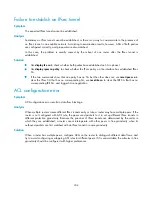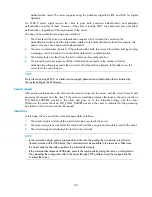
292
To do…
Command…
Remarks
10.
Enable the NAT traversal function
for IPsec/IKE.
nat traversal
Optional.
Required when a NAT gateway is
present in the VPN tunnel
constructed by IPsec/IKE.
Disabled by default.
11.
Set the
subnet
types of
the two
ends.
Set the subnet type
of the local end.
local
{
multi-subnet
|
single-
subnet
}
Optional.
single-subnet
by default.
Used only when the router is
working together with a
NetScreen device.
Set the subnet type
of the peer end.
peer
{
multi-subnet
|
single-
subnet
}
12.
Apply a DPD detector to the IKE
peer.
dpd
dpd-name
Optional.
No DPD detector is applied to an
IKE peer by default.
For more information, see
"
."
NOTE:
After modifying the configuration of an IPsec IKE peer, execute
reset ipsec sa
and
reset ike sa
to clear
existing IPsec and IKE SAs. Otherwise, SA re-negotiation fails.
Setting keepalive timers
IKE maintains the link status of an ISAKMP SA by keepalive packets. Generally, if the peer is configured
with the keepalive timeout, you must configure the keepalive packet transmission interval on the local
end. If the peer receives no keepalive packet during the timeout interval, the ISAKMP SA is tagged with
the TIMEOUT tag (if it does not have the tag) or is deleted along with the IPsec SAs it negotiated (when it
has the tag already).
To set the keepalive timers:
To do…
Command…
Remarks
1.
Enter system view.
system-view
—
2.
Set the ISAKMP SA keepalive
interval.
ike
sa
keepalive-timer
interval
seconds
Required.
No keepalive packet is sent by default.
3.
Set the ISAKMP SA keepalive
timeout.
ike
sa
keepalive-timer
timeout
seconds
Required
No keepalive packet is sent by default.
NOTE:
The keepalive timeout configured at the local end must be longer than the keepalive interval configured
at the remote end. Since it seldom occurs that more than three consecutive packets are lost on a
network, the keepalive timeout can be configured to be three times the keepalive interval.
















































